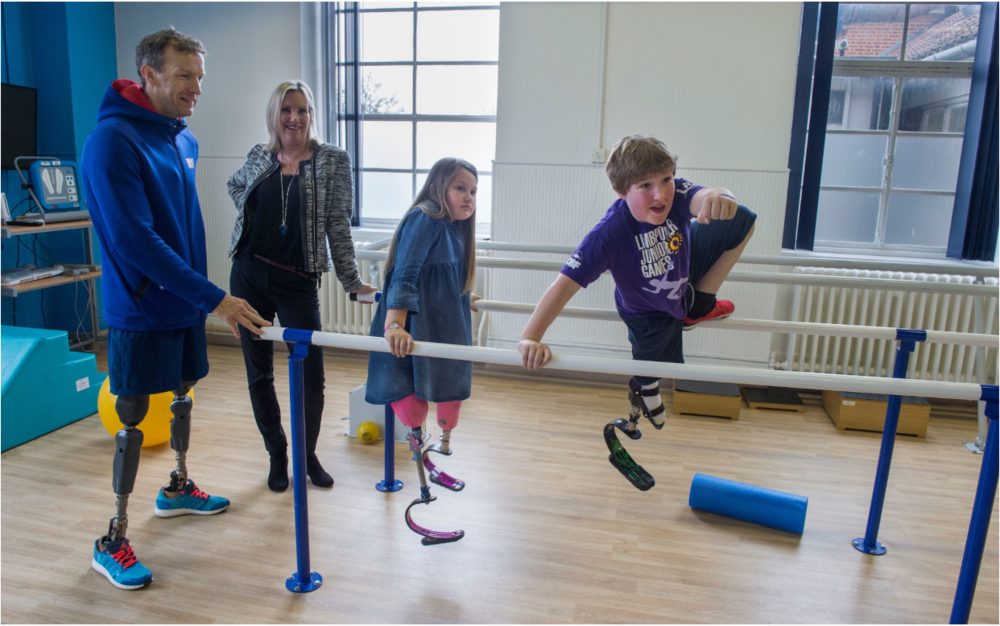
NEXT GENERATION OF DISABLED CHILDREN TO BENEFIT FROM GOVERNMENT INVESTMENT IN SPORTS PROSTHETICS
Posted by LimbPowerAdmin on Wednesday 11th April 2018
NEXT GENERATION OF DISABLED CHILDREN TO BENEFIT FROM GOVERNMENT INVESTMENT IN SPORTS PROSTHETICS
HUNDREDS of children with limb loss are set to benefit from a further £1.5 million investment into sports and activity prosthetics under plans announced by Care Minister Caroline Dinenage today.
The next stage of a Government fund for sports prosthetics – launched in March 2016 – will mean children who have suffered limb loss or who were born with a limb deficiency will benefit from the latest prosthetics.
The fund – which has already supported 220 disabled children – will mean more children will be able to use sporting prosthetics, including running blades, as well as supporting research and innovation to improve prosthetic technology for the future.
Minister of State for Care, Caroline Dinenage, said:
“Sport and activity are so important to any child’s health, wellbeing and confidence, and today’s announcement should help many more disabled children to fulfil their sporting ambitions.
“Hundreds have already benefitted from the fund, and this additional investment will now help us to open up even more possibilities for children with limb loss, and hopefully ignite in them a lifelong passion for sport.”
A £1.5 million investment to the fund was previously announced in September 2016, with £750,000 funded through the National Institute for Health Research (NIHR) to create a Child Prosthetics Research Collaboration.
The aim of this research collaboration is to bring together leading national research centres with capabilities in child prosthetics with key experts from the NHS, industry, and clinical academia.
The collaboration is helping to ensure research across the system accelerates new discoveries and pioneers new developments into child prosthetics.
This additional funding will help to build upon the collaboration’s early positive results which include the use of 3D printing in developing bespoke breathable prosthetic socket liners, a prototype game environment to help children train their muscles to control their prosthetic limbs, as well as the development of myoelectric, or ‘bionic’ upper limb prosthetics for children.
Richard Whitehead MBE, double leg amputee and double Paralympic champion in T42 200m, said:
“As a double gold Paralympian and four time world champion, I think it’s important that the Paralympics don’t just leave a legacy every four years and then are otherwise forgotten about.
“I’m the most successful athlete who uses sports prosthetics, so I’ve seen first-hand the powerful impact they can have. A child taking just one or two steps using these prosthetics can make the world of difference and open their eyes to what they can achieve.
“As a patron of LimbPower, it’s up to me to empower, liberate and inspire the next generation of disabled children and sports prosthetics are a great platform to do that, so I’m so pleased the Government has announced it will invest more money into this vital fund.”
Kiera Roche, chief executive of LimbPower, the Nationality Disability Sports Organisation for people with limb impairments, said:
“LimbPower is delighted with the incredible news that the Department of Health and Social Care will continue the fund for a further two years.
“The impact this has had on the 220 children who have so far received their activity limbs is immeasurable.
“Children just want to be able to join in and feel included, especially at school and in the community, and this means playing and taking part in P.E. and games.
“The overriding messages we have received from children and parents is that they can be included, join in, run and jump just like their friends; they can be children and not patients.”
Sarah Hope, whose daughter Pollyanna was one of the first children to receive a limb through the fund, said:
“I am so thrilled that the Government have said they will continue to invest in the fund so that all amputee children or children who have a limb deficiency will be able to have a running blade!
“Children are born with the desire to be free to run like the wind, join in with sport, to play with their friends and to walk without difficulty. My daughter, who has lost her right leg below the knee, has chosen to dance like an angel.
“We must always remember that amputees are missing a part of their body, so we really need to give them the very best we can so they can try to live the life they were born to live
“The running blade is lighter than a normal prosthetic leg, the ankle is springy so it has more movement and it is not possible to keep active, fit and healthy with a normal prosthetic leg with very little movement in the ankle.
“The children who have already received a running blade have said their lives have been transformed. My daughter immediately became a gymnast and a dancer and she has not looked back!”
-ENDS-
Case studies available on request. Please contact the DHSC media centre for more details.
Notes to Editors
1.In the March 2016 budget, Chancellor George Osborne announced that the Government was investing £1.5 million in child prostheses over two years, giving hundreds of children with limb deficiency access to sports prostheses and creating a fund to incentivise the development of innovative prosthetics products for the NHS.
2.In October 2016, the Secretary of State for Health, Jeremy Hunt, agreed that of the £1.5 million, £750,000 would be ring fenced up until the end of financial year 2017/18 for providing sports and activity prostheses for children in England who have suffered limb loss or who were born with a limb deficiency.
3. Children and families can access the fund by attending an Artificial Limb Centre also called a Disablement Service Centre for an assessment. Parents can make an appointment with the Artificial Limb Centre they attend and speak with the Rehabilitation Consultant and or Prosthetist.
